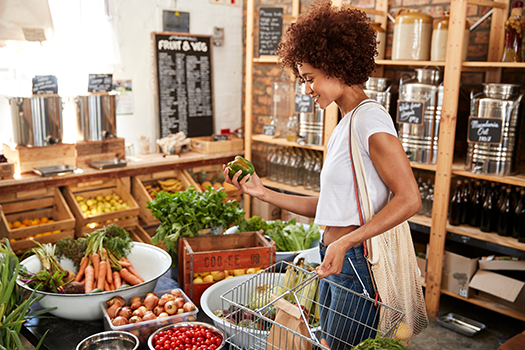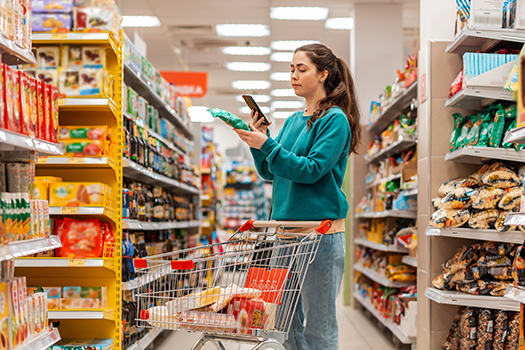Blog Posts
Challenges to Supply Chain Sustainability
5 minute read
5 minute read
Food production has a significant impact on the environment.
Research shows food production and its associated activities are responsible for 26% of the world’s greenhouse gas emissions. That 26% includes everything from packaging to supply chain operations, livestock, crops, and land use.
Though imperative to food and beverage organizations, environmental concerns aren’t the only factor driving companies to prioritize sustainability and environmental, social, and governance (ESG) goals.
Creating a sustainability agenda is vital for organizations that want to appeal to consumer preferences, boost their reputation, and stay competitive in the market.
In this blog, we highlight the top focuses for food and beverage companies that want to capitalize on consumer and market trends around sustainability.
Consumers are increasing their consumption of plant-based products due to personal wellness and environmental concerns.
Of the 26% of global greenhouse gas emissions caused by food production, livestock and fish farms account for the biggest category percentage (31%) of impact compared to crop production (27%), land use (24%), and supply chain activities (18%).
Because of this significant ecological impact, many consumers are adopting a “flexitarian” diet, which is primarily plant-based but includes the occasional consumption of meat/fish.
Additionally, personal wellness is a significant driver. In a McKinsey survey on conscious eating, 40% of consumers who eat plant-based products reported doing so for personal health reasons rather than the health of the environment.
Due to these combined factors, plant-based products are significantly increasing in popularity. Whole Foods recently released their 2024 food predictions, and plant-based foods are highlighted among the most prominent trends. The health retailer predicts a heightened focus on putting the “plant” back in “plant-based,” with brands using mushrooms, walnuts, tempeh, and legumes rather than complex meat alternatives.
Read Case Study: Strategic Planning for Plant-Based Category Growth

It’s no secret packaging waste is a problem, which means the pressure is on for companies to adopt alternative solutions.
Here’s a snapshot into what food and beverage brands are doing:
Many major companies have announced positive changes to packaging this year, including PepsiCo switching to paperboard beverage multipacks, KraftHeinz creating a paper-based ketchup bottle, and Nestlé working towards its goal of recyclable plastic packaging.
However, despite the avalanche of commitments to better packaging, a new problem is arising: There’s a lot of confusion from consumers around recycling best practices. In fact, research shows about 66% of paper products get recycled, 50% of aluminum cans, and a mere 5% of plastic waste.
The good news? The future is bright, and consumers and organizations are committed to figuring it out together. CPG and food and beverage brands are continuously making positive changes to packaging, and consumers are concerned about their impact. In fact, 60-70% say they’d pay more for sustainable packaging.
Read: Supply Chain Trends & Insights Report: Innovation
The upcycled food market is booming. Though it’s mainly been picking up steam the past few years, the market is expected to reach $97 billion by 2031, growing at a CAGR of 6.2%.
First off, what are upcycled foods? Upcycled foods are items made from ingredients that would’ve otherwise been wasted. An easy-to-understand example is using overripe bananas to make banana bread at home rather than throwing them out.
Upcycling food is needed: The U.S. Department of Agriculture estimates 30-40% of the U.S. food supply goes to waste.
Consumer preferences and the high cost of raw materials are two key reasons food and beverage organizations are expanding their upcycled food offerings. A popular model is produce services like Imperfect Foods and Misfits Market that upcycle “ugly” food items that would generally get wasted for not meeting traditional standards of what food should look like.
Upcycled packaged food you might see on the shelf includes:
Most grocery stores sell upcycled products—you may just not know it. Look for the official Upcycled certification label next time you’re doing your Sunday shopping and join the upcycling movement.

Local sourcing continues to be a top trend for food and beverage organizations.
There are many benefits to sourcing food items locally, including:
Restaurants in particular are capitalizing on local sourcing more than ever. By sourcing local, organizations can shorten their supply chains, maintain inventory, and appeal to sustainability- and community-minded consumers. Considering a National Restaurant Association survey found 76% of adults are more likely to visit a restaurant that serves locally sourced food, it’s unlikely this trend will die down anytime soon.
Additionally, more major CPG brands are incorporating local sourcing into their offerings. To accomplish this, manufacturers team up with local farms and suppliers to create products regionally and use contract manufacturers to produce the finished product from the locally grown supplies. This enables them to incorporate local ingredients into their products without the high cost of opening a nearby warehouse or manufacturing plant.
Read: Improving Supply Chain Sustainability: 5 Ways to Get Started
With the spotlight shining bright on company reputations, brands need to prioritize trustworthy, clear, and transparent marketing when it comes to sustainability and ESG. Here’s what that looks like:

Catena Solutions specializes in supporting supply chain-based organizations with their business initiatives with an emphasis on value creation and cost optimization. We do so by connecting you with our network of experienced professionals to advise and execute on client-managed projects. Contact us to learn more.